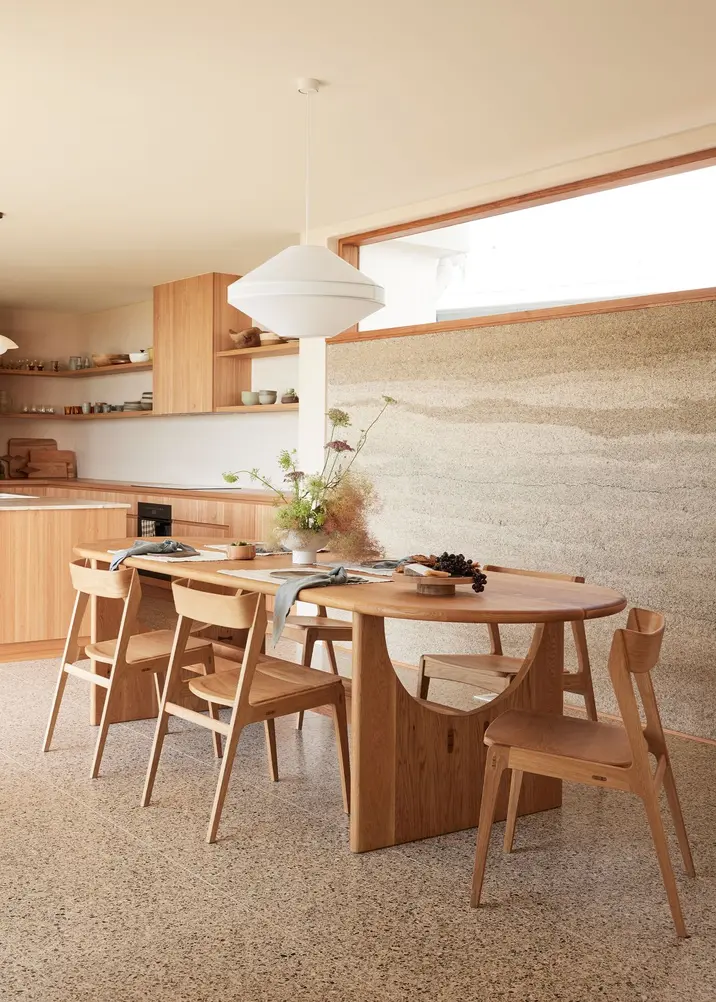
Save yourself time and money with these insightful tips.
Renovating Your Home? Here Are the 11 Most Common Mistakes to Avoid
Save yourself time and money with these insightful tips.
Even with all the money in the world, or months and months of planning, it's virtually impossible for a home renovation to go 100 per cent smoothly without at least a few hiccups along the way. Beyond the things we can control, there's everything we can't. Like the weather, for one. But what is life if not one surprise after another?
"I think those hiccups can sometimes be what make renovations so special!" says Prudence Oliveri, one half of Oliveri Design & Construction –and the artist also known as Prudence Caroline (who you may remember from her The Makers home tour). "There's a uniqueness that comes from having to work with what you've got and not starting from scratch," she says. "And you're always learning along the way, so you always come out the other side with knowledge you didn't have before."
Together with her husband, Damien, Prudence works on home renovation projects specialising in concrete design and construction. One of their most recent projects was a concrete home in regional Victoria overlooking the Great Ocean Road. Right now they're working towards building a space of their own, and have set up shop for the time being in a light-filled home in the coastal suburb of Torquay.
We reached out to find out what some of the most common mistakes people make when it comes to renovating their homes. From failing to budget, failing to plan and neglecting outside spaces, here's what she had to say.
Mistake #1: Removing original fixtures
One of the most common mistakes people make when undertaking significant updates to their homes is over-modernising. "Working with existing accents of an old home is often what makes the result so special," Prudence says. Original crown moulding, interior brick walls, timber floorboards – these have all become treasured design aspects of older homes. But what if you're envisioning a sleek, minimalist or monochromatic space? Absolutely you do, but that white bamboo flooring might not seem like a good idea a few years from now, especially given the time you spend daily mopping up every little mark.
Solution
Make a list of every original feature in your home that could be worth restoring, and build the cost into your budget. Talk it out with a friend or relative who appreciates interior design, and spend some scouring Pinterest for reference images that combine old with new.
Mistake #2: Not working to a budget
Knowing how to budget is Life 101, and yet it's a skill many people lack. It comes down to being honest and realistic with yourself. Become an expert at organising your thoughts and feelings. Make lists. Separate your needs from your wants and assign a dollar value to each one. When estimating the cost of each line item, add a 15-20% buffer on top to account for surprises.
Solution
Come up with your ceiling – the most you can possibly and realistically spend – and start from there. Write a list of every necessary step in your renovation project and the jobs that need to be done in each one. Once you have a rough outline of what you're doing, you can assign estimated dollar values and get clearer on how much you can spend on what.
Next, it's time to get up close and personal with Google Spreadsheets. If you're a pro, set up your own budget sheet. If not, try looking online for an easy-to-understand budget spreadsheet template. Overwhelmed? Phone a friend – everyone's got that friend who loves spreadsheets, and this is their time to shine. Enter each cost in a separate line, with estimated costs to start and update it with actual costs when the time comes.
Mistake #3: Not planning ahead
It seems obvious, but it bears repeating: plan, plan, plan. When you're investing serious money and time in any sort of home renovation, big or small, it is crucial to spend time thinking, planning and reflecting before buying materials and hiring tradespeople.
"If you're able," Prudence says, "living in the home for a few weeks or even months before renovations begin will give you a much better idea of what changes you need." You might think you know straight away which walls you want to get rid of and the type of flooring you'd like to replace the out-of-date linoleum with. But until you've spent time in the house living your regular routine, you may forget how the everyday habits of your home's inhabitants impact the space.
For example, sandstone flooring might be the aesthetic you want but is it what you need? Sandstone is light and porous, and might not be appropriate for the kitchen, or if you have indoor/outdoor pets that can track dirt and dust everywhere they go. Likewise, a big beautiful bathroom seems like a nice idea, but keeping the toilet in its own cubicle with a door will prevent morning arguments for years to come.
Solution
Think, write lists, reflect, talk it out. The more productive planning you do, the better the outcome. The key word here is productive. When planning starts to feel like procrastination, it's time to ask yourself whether your hesitation to move forward indicates a real problem – perhaps you've under-budgeted and deep down know you really can't afford that pricey stone bench-top but keep putting off pivoting to a more affordable option. There's no shame in scaling back when you need to, and it's better done sooner than later.
Mistake #4: Not building in buffers
Always allow extra time for construction, as weather-related delays should be expected. Likewise, always budget 15-20 per cent extra budget on each line item to account for surprises and anomalies.
Solution
Add 15-20 per cent to any estimation you make, whether it's an amount of time or a dollar amount. Ideally, you won't need to spend that buffer every time, but when you are hit with a surprise bill or see a fortnight of rain in the weather forecast, you'll be glad you over-budgeted.
Mistake #5: Poor people management
Hiring tradespeople can be a daunting task, especially for first-time renovators. If the budget allows it, hiring a builder to manage down will save you time and many headaches. If you are managing the project yourself, Prudence says it's important to have all your tradespeople lined up to prevent delays and most of all be extremely clear in all of your communication with them. Ask around, get references, do your research, and remember, if there was ever a time to ask for what you want, it is now.
It goes both ways – if you are unclear on part of a quote or timeline from a tradesperson, ask them to elaborate. When you're investing serious money into a big project, it can be easy to overthink interactions and second-guess contractors. Ultimately, all you can do is speak your truth and trust the people you bring on will be honest, reliable and good at what they do.
Solution
Be clear, be kind, be courteous, and show up where and when you need to, i.e. pay invoices on time, query inconsistencies where relevant, and give clear feedback without micromanaging.
Mistake #6: Trying to do too much too quickly
Sure, there are 24 hours in each day and seven days in each week. On paper, when you're trying to get the absolute most and best out of a limited budget to create the home of your dreams, it might seem like a totally normal idea to say you'll spend a few hours each night painting the walls or sanding the floors yourself. You only work eight hours a day and you only sleep for another eight, that's a whole eight hours of spare time! Right?! Wrong. Of course, you know this is crazy, but when it comes to renovations and just the whole general concept of self-managing a home renovation, you'd be surprised at how far you'll try to push it.
Prudence and Damien are highly experienced in the home construction game, but even they fall into the trap of trying to do too much too quickly. "During our last reno we smashed three windows in a six-week timeframe," she says.
Solution
Trying to do too much too quickly is risky, and can end up costing you more time and money than you would have with a more realistic schedule. In addition, going too hard on the DIY of it all can leave you stressed, exhausted and even injured. Then what good are you? If there's some aspect of the project you'd like to do yourself, just give yourself a relaxed timeframe to get it done, i.e. a few hours on weekends.
Mistake #7: Following trends
Trends can be great to take inspiration from, but if you follow them blindly there's a high chance you'll be sick of them as soon as they are no longer a trend.
Solution
Go nuts on Pinterest, but pause before making any wild purchases. Think of it like this: you are your client. Your client (you) has given you X amount of dollars to spend on a home renovation project. Don't make recommendations that don't meet the client's needs or aesthetic sensibilities. Your client (again, you) might keep suggesting bold colours for her walls, but ask the right questions and she (you) will reveal she has never as much worn a bright tank top let alone spent lots of money on peacock-blue wall paint.
Mistake #8: Neglecting the garden
Landscaping is equally important as the house when it comes to full-scale renovations, Prudence says. If you're lucky enough to have a sizeable garden, you won't regret paying some attention during your renovation process. Time outside is crucial to a well-rounded lifestyle, and if you've got your own private outdoor space at home why not make it a sanctuary? Invest in discrete outdoor storage for all of the clutter (rakes, tools, extra seating) and think about what will encourage you to spend more time there.
Solution
Assign some of your budget to the garden. Consult your local nursery about which native plants they recommend for your garden based on their aspect and exposure to the sun. Or, if budget allows, hire a landscaper. If you're dealing with more of a tiny courtyard situation, give your outdoor space a refresh by bringing in new-to-you outdoor furniture, or even just some ambient outdoor lighting.
Mistake #9: Waiting to choose appliances
It's more common than you'd think: you're nearing the end of a kitchen renovation and decide it's time to buy a new fridge. You find your dream fridge (yes, there is such a thing) only to find out the new alcove is just too narrow. The dream is over.
Solution
Choose your appliances early on, without necessarily purchasing them straight away.
Mistake #10: Lazy lighting
Lighting is often one of the most overlooked aspects of the home renovation process, according to Prudence. But the lighting of a room is at once form and function. Think about the tasks you need to perform in each space as well as the mood you want the space to carry. You may also want to think about the location of your light switches—hidden switches can help the décor to shine.
Solution
Add lighting to your plan and your budget. Decide what extent you want to revamp the lighting in each room – instead of a brand new lighting system that requires an electrician, you may just want to update the shades on your overhead pendant lights.
Mistake #11: Thinking short-term
It's crucial to stick to your budget and spend conservatively, but this doesn't necessarily mean choosing the least expensive option every time. Where it pays to stretch your budget as far as it can go is in regard to quality materials that last. "Choose quality where you can," Prudence says. "Get it right from the beginning so you don't have to do it again in five years time."
For example, quality windows with thermal properties and beautiful frames can make a huge difference to the function and feel of a home. If your budget allows for steel instead of aluminium, it could be worth the extra spend in the long run.
Solution
Budget wisely and try to decide what aspects of your renovation require or deserve more of that budget.
Enjoyed This?
Discover more home improvement articles.












